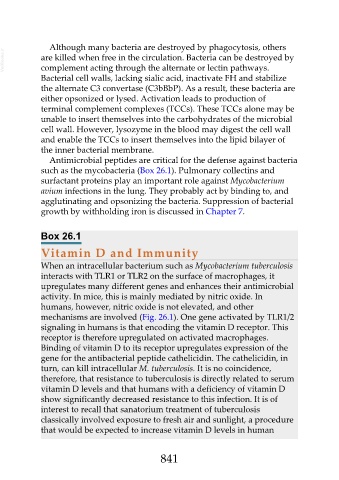Page 841 - Veterinary Immunology, 10th Edition
P. 841
Although many bacteria are destroyed by phagocytosis, others
VetBooks.ir are killed when free in the circulation. Bacteria can be destroyed by
complement acting through the alternate or lectin pathways.
Bacterial cell walls, lacking sialic acid, inactivate FH and stabilize
the alternate C3 convertase (C3bBbP). As a result, these bacteria are
either opsonized or lysed. Activation leads to production of
terminal complement complexes (TCCs). These TCCs alone may be
unable to insert themselves into the carbohydrates of the microbial
cell wall. However, lysozyme in the blood may digest the cell wall
and enable the TCCs to insert themselves into the lipid bilayer of
the inner bacterial membrane.
Antimicrobial peptides are critical for the defense against bacteria
such as the mycobacteria (Box 26.1). Pulmonary collectins and
surfactant proteins play an important role against Mycobacterium
avium infections in the lung. They probably act by binding to, and
agglutinating and opsonizing the bacteria. Suppression of bacterial
growth by withholding iron is discussed in Chapter 7.
Box 26.1
Vitamin D and Immunity
When an intracellular bacterium such as Mycobacterium tuberculosis
interacts with TLR1 or TLR2 on the surface of macrophages, it
upregulates many different genes and enhances their antimicrobial
activity. In mice, this is mainly mediated by nitric oxide. In
humans, however, nitric oxide is not elevated, and other
mechanisms are involved (Fig. 26.1). One gene activated by TLR1/2
signaling in humans is that encoding the vitamin D receptor. This
receptor is therefore upregulated on activated macrophages.
Binding of vitamin D to its receptor upregulates expression of the
gene for the antibacterial peptide cathelicidin. The cathelicidin, in
turn, can kill intracellular M. tuberculosis. It is no coincidence,
therefore, that resistance to tuberculosis is directly related to serum
vitamin D levels and that humans with a deficiency of vitamin D
show significantly decreased resistance to this infection. It is of
interest to recall that sanatorium treatment of tuberculosis
classically involved exposure to fresh air and sunlight, a procedure
that would be expected to increase vitamin D levels in human
841

